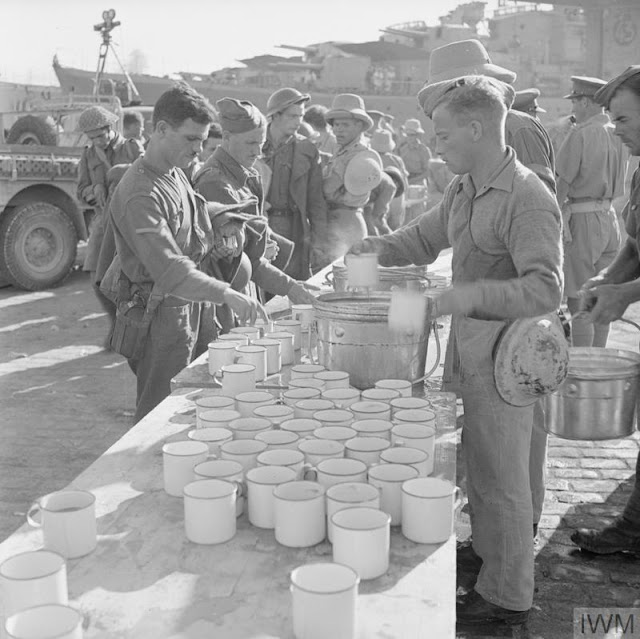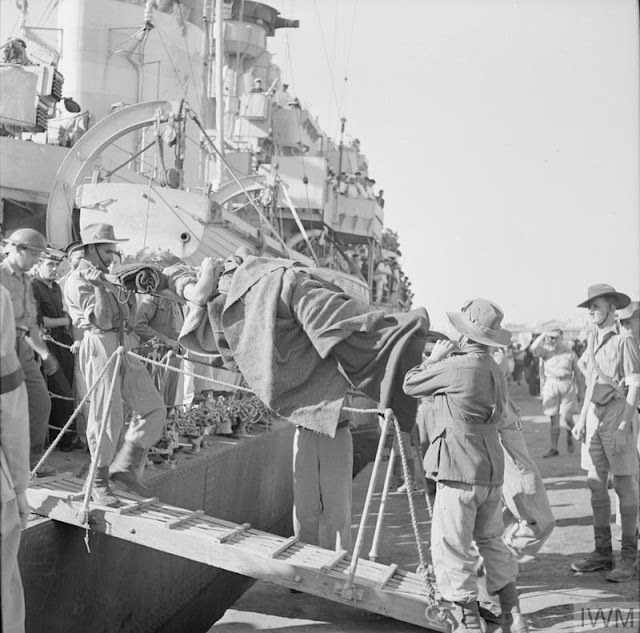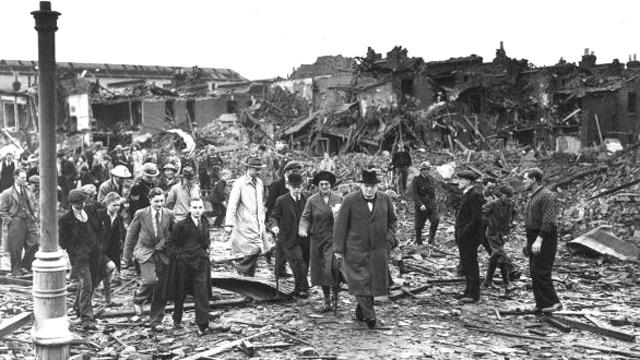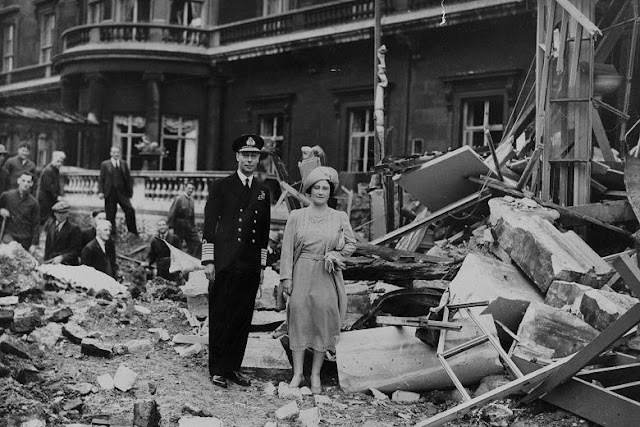Saturday 31 May 1941
The British decide not to occupy Baghdad, which is a very practical decision due to the small strength (1200) of British forces in the vicinity. The British invite Prince 'Abd al-Ilah to return to the city. As part of the armistice, both sides release prisoners (except for German and Italian POWs of the British). The British allow the Iraqi troops to return o their barracks with their equipment.
Without an effective government, Baghdad descends into an orgy of looting and attacks. The government heretofore has protected the city's Jewish Quarter, but now that protection is gone. About 120 Jewish inhabitants perish and 850 are injured before the British and the incoming (returning) government restore order.
Without flyable planes, the German military mission (Sonderkommando Junck) departs for Syria on foot (the last arriving 10 June). The eight or so Italian Fiat CR-42 fighters of 155th Squadriglia still operational at Kirkuk fly to Syria, thence to Rhodes (two are destroyed by the Italians as unusable).
In the Reich, Reichsmarschall Hermann Goering makes a lame attempt to explain the Iraq disaster to Hitler and Foreign Minister Joachim Ribbentrop:
They don't know anything about aviation out there, and airlifting fuel would have been pointless and costly.It is a feeble excuse for the utter failure of the Luftwaffe in Iraq. The British have managed to win in Iraq precisely because of its adroit use of airpower. The failed Iraq campaign probably never was a winnable proposition for the Axis due to the inherent British advantages in the region (large numbers of Indian troops close at hand, for instance), but Germany could have made a better showing and thereby curried stature within the Arab world.
 |
| "Lieutenant General Bernard Freyberg VC, commanding officer of the British forces on Crete, gazes over the parapet of his dug-out in the direction of the German advance, May 1941." © IWM (E 3020E). Freyberg leaves Crete on a Sunderland flying boat in the early hours of 31 May 1941. |
May 1941 marks the end of the Blitz or at least the most effective and devastating phase of it. The Luftwaffe is busy moving aircraft to Poland in order to support future operations in the Soviet Union. British civilian losses for the period September 1940 - May 1941 inclusive, which do include some military personnel on leave and the like, are estimated to total 39,678 dead and 46,119 injured.
At Black Tarset Street, Newcastle upon Tyne, four people, including a seven-year-old girl and an eleven-year-old Boy Scout, succumb to gas fumes emanating from a bomb crater. Two firemen (Larry Young and Leading Fireman Bruce) descend into the crater to rescue them. Young manages to retrieve the bodies and also rescue Bruce, who passes out from the fumes. Larry Young receives the George Medal for his gallantry and Bruce is commended. One of the victims, Auxiliary Fireman Wanless, earns a posthumous commendation.
 |
| Londoners wearing gas masks during a gas drill in Richmond Surrey, 31 May 1941. The Blitz is over, but nobody knows that. |
Battle of the Atlantic: It is a big day for the U-boat fleet. A massive presence of U-boats has been sent into the Atlantic in support of (now sunk) battleship Bismarck and heavy cruiser Prinz Eugen, and today the move pays off - though it is fairer to say that the U-boat fleet sinkings are simply time-shifted due to the dispositions rather than there being any net increase over what would normally have taken place.
U-106 (Kptlt. Jürgen Oesten), on its extended second patrol out of Lorient, spots an unescorted freighter north of the Cape Verde Islands. Oesten pumps one torpedo into 6843-ton British freighter Clan Macdougall, the first at 03:31, the second at 03:45. There are two deaths and 85 survivors who make it to the islands.
U-69 (Kptlt. Jost Metzler), on its third patrol out of Lorient, penetrates the harbor of Accra, Ghana and fires a torpedo at 5445-ton British freighter Sangara. The Sangara sinks in 33 feet of water, and her bow remains visible. The Sangara will be salvaged in 1943 (refloated, cargo recovered and sold) and returned to service in 1947.
U-107 (Kptlt. Günther Hessler), on its second patrol out of Lorient, is operating near Freetown, Sierra Leone when it spots 5664-ton British freighter Sire. Hessler hits Sire on the starboard bows with a torpedo, and the Sire sinks in ten minutes. There are three deaths, while the 46 survivors (including the master) are picked up by HMS Marguerite.
 |
| SS Gravelines, sunk by U-147 on 31 May 1941. |
U-204 (Kptlt. Walter Kell), on its first patrol out of Kiel, is operating in the Denmark Strait (northwest of Dyrafjordur, Iceland) when it spots 16 Icelandic fishing boat Holmsteinn. Kell decides not to waste a torpedo on it, and also wants to disable its wireless before the position can be broadcast, so surfaces and sinks it with gunfire. All four aboard perish.
U-38 (Kptlt. Heinrich Liebe), on its extended ninth patrol out of Lorient and operating off Liberia, hits independent 6029-ton Norwegian freighter Rinda with two torpedoes at 00:24. There are five deaths immediately, including the master, and more when the ship sinks before the boats can be launched. There are 18 survivors. The ship's sinking is noted by the rescue of ship's cat Rinda, who is found swimming after the ship sinks by the men in the lifeboat, which the survivors manage to right. Rinda serves out the war on the rescue ship, HMS Pict.
German heavy cruiser Prinz Eugen spends its last full day at sea in the Atlantic, heading toward Brest with engine trouble. Despite numerous Royal Navy warships in the vicinity and RAF patrols, nobody spots it.
US Navy Task Group 1, led by the aircraft carrier USS Yorktown (CV-5), departs from Bermuda on a two-week neutrality patrol. It will cover over 4500 miles (7424 km). Yorktown carries VF-41, VS-41 and VS-42, and VT-5.
For the month of May 1941, total Allied shipping losses in the Battle of the Atlantic fall slightly, from 616,469 tons to 486,796 tons. This is primarily due to a steep drop in losses to surface raiders, from 91,579 tons to 15,002 tons, and to the Luftwaffe, from 323,454 tons to 146,302 tons. U-boat losses actually rise, from 249,375 tons to 325,492 tons.
 |
| "New Zealand soldiers from 19th Battalion on board an Australian destroyer (either HMAS Nizam or HMAS Napier) following their evacuation from Crete, c. 31 May 1941." (New Zealand History). |
There is 1 U-boat sunk in the Atlantic (U-110, briefly captured), Arctic or Baltic, and 32 serviceable U-boats are on duty in the Atlantic. The Italians continue to maintain a strong submarine presence out of Bordeaux, but, while they make occasional sinkings, generally their patrols are much less efficient in terms of enemy aircraft sunk that Kriegsmarine craft.
Commodore L.W. Murray RCN is appointed Commander of the Newfoundland Escort Force (NEF). He reports to Commander-in-Chief, Western Approaches, Admiral Sir Percy Noble in Liverpool.
Convoy OB 329 departs from Liverpool, Convoy WS 8X (Winston Special) departs from the Clyde bound for Freetown and thence Capetown. WS 8X is escorted by the aircraft carrier HMS Victorious, showing its importance - it includes large transports Duchess of Bedford (20,123 tons) and Waiwera (10,800 tons), among other ships.
Royal Navy tug HMS Dart is commissioned.
Canadian corvette HMCS Sudbury is launched at Kingston, Ontario.
U-502 (Kptlt. Jürgen von Rosenstiel) is commissioned, U-435 is launched, U-291 and U-617 are laid down.
Soviet submarine SC-411 is launched.
 |
| "Evacuation: The troops being served with tea on the quayside after disembarking at an Egyptian port. Lieutenant-General Sir Bernard Freyberg VC ordered the evacuation to commence on 28 May 1941. 16,500 were rescued, including 2000 Greeks. The rest were left dead or prisoners in German hands." 31 May 1941 © IWM (E 3295). |
During the night of 31 May/1 June, about 4,000 men are taken off. These are the final evacuations from Sfakia. Light cruiser HMS Phoebe leads the evacuation contingent there. They are covered by a large force including cruisers Calcutta and Coventry. The Luftwaffe damages destroyer Napier, one of the ships at Sfakia.
There are 16,511 men land at Alexandria on 31 May 1941 from Crete. However, this is just a fraction of the thousands of British and Dominion troops still on the island, let alone thousands of Greek soldiers. Many of the Allied soldiers barely escaped from the mainland during the Germans' Operation Marita, and now they find themselves caught in the same kind of trap on Crete. A small number can be taken out by two Sunderland flying boats, but only 54 senior officers (including General Freyberg) make it out that way.
 |
| A British soldier stands by a cave on Crete being used as an air-raid shelter. Many British Commonwealth troops left behind after the evacuation would make use of such caves to avoid capture (© IWM (E 3022E)). |
The Germans and Italians seize a large number of ships at Suda Bay:
7258 ton British freighter Araybank (damaged, taken to Trieste)The Italians have a case of friendly fire when one of their bombers accidentally drops a bomb on Italian torpedo boat Pleiadi near Tobruk. The master runs it aground and eventually is written off.
6343 ton British freighter Dalesman (beached, taken to Trieste)
6397 ton Greek freighter Nicolauou Ourania, beached but refloated and renamed Nikolaus for German use
7073 ton British tanker Olna (beached, but refloated and used).
In Malta, it is a quiet day in the air. However, the ruins of the building that housed the former Courts of Justice fall into the city's main street. This blocks Kingsway until the street can be cleared.
 |
| "Evacuation: A wounded soldier being brought ashore on a stretcher at an Egyptian port after the evacuation from Crete. A total of 16,500 were rescued, including 2000 Greeks. The rest were left dead or prisoners in German hands." 31 May 1941 © IWM (E 3284). |
Predatory actions alleged against the crew and those aboard to look after the 2700 refugees aboard include savage beatings and theft. One refugee jumped overboard. Many aboard the vessel are Jews fleeing continental Europe, and it is believed that some already had been in concentration camps.
The courts-martial hold three men guilty. These include Major William Patrick Scott, the ship's master, who is severely reprimanded. His regimental sergeant major is jailed for 12 months.
Not enough is known about the Dunera Chelsea Barracks proceedings to affix firm dates to matters related to them. Note that other relevant dates are 18 February 1941, when a decision to hold a court of inquiry is confirmed, and 13 May 1941, when the issuance of a report of the court of inquiry is confirmed. References are made to the proceedings in the 24 February 1941 Commons Official Report and the 17 January 1979 records of the House of Lords.
 |
| General Freyberg on the cover of Illustrated London News, 31 May 1941. |
clear that a court of inquiry was held. No details are given about its composition, though it is recorded that only one internee was available to give evidence to it. This is the only available evidence relating to the holding of the inquiry, and it must be assumed that the full record of the proceedings was subsequently destroyed in accordance with the rules about disposal of public records applicable at the time.This Dunera incident is a rare incident of a warring power prosecuting its own military personnel for improper and abusive conduct during World War II. While the Germans did this at times, it was rare despite many occasions when it most certainly was warranted. The Wehrmacht had standing orders at various times and places throughout the war to be given "leave to not prosecute" soldiers for war crimes.
As a coda to this sad chapter, many of the HMT refugees ultimately returned to England after the war. A sizeable fraction remained in Australia and began new lives there. All traces of the camp where they were interned have disappeared save the access road and a memorial plaque.
On Crete, the temporary commander of Crete General Kurt Student responds to demands from his Fallschirmjäger by publishing an order authorizing reprisals against the local population. Many German troops are incensed at military actions taken against them by Greek civilians on the island and want revenge. This order plants the seeds for long-lasting hatred between Cretan civilians and Germans that extends long past the war.
The reprisals are to consist of shooting, fines, burning villages or even extermination of the male population. Several senior officers leave the conference in protest of the order, but it does go into effect and reprisals are taken. This will lead to charges made against General Student after the war.
 |
| "Evacuation: Women and children, civilian refugees from the fighting come ashore at an Egyptian port after their evacuation from Crete. A total of 16,500 were rescued including 2000 Greeks." 31 May 1941 © IWM (E 3288). |
POWs: Lieutenant Peter Allan of the Queens Own Cameron Highlanders, who escaped from the Colditz Castle POW camp in a mattress carried by French Army POWs on 10 May 1941, makes it to Vienna. He had attempted to escape for Switzerland but had insufficient rations, so headed east to Vienna. Allan had walked into the US consulate there asking for help to reach Budapest and neutral Hungary. After the consul refused (there are German staff who witness the encounter), Allan went across the street and fell asleep in a park. Frozen by the night air, Allan crawled to a nearby house and surrendered. He is taken to a hospital, then back to Colditz today.
US Military: The US Army Air Corps assigns the P-40 Warhawk fighters of 22nd and 23rd Fighter Squadrons to St. Croix Airfield, US Virgin Islands.
Minor changes are ordered for naval uniforms. Henceforth, the eagle is to face to the left for the Seaman Branch, Boatswain Mate, Turret Captain, Signalman, Gunners Mate, Fire Controlman, Quartermaster, Mineman and Torpedoman's Mate.
 |
| Parade magazine, 31 May 1941. |
Switzerland: Rationing of coffee, tea, and cocoa is instituted.
Belgium: The government begins expropriating the property of Jewish residents.
British Homefront: Preston North End beat Arsenal 2-1 in the Cup Final replay.
Rationing of eggs begins. Rationing of Fish and milk tightens.
American Homefront: Isolationist Senator Hiram W. Johnson (California) makes a radio broadcast for the America First Committee. He notes that the US now is "at the brink of war," which he attributes to President Franklin Roosevelt breaking a long string of promises to keep the country out of the war. He cites advocates for war as:
a smattering of good citizens, the vociferous little puppets of J. P. Morgan and Co., a large part of the press, practically all the columnists, the newspaper correspondents, all crying for war with Germany and against Hitler.He admits that support for Britain is popular, but "with the proviso that it should be 'short of war.'"
 |
| "Walking wounded British troops disembarking at a port in Egypt after the evacuation of Crete, 31 May 1941." © IWM (E 3282). |
May 1941
May 1, 1941: British Hold Tobruk
May 2, 1941: Anglo-Iraq War
May 3, 1941: Liverpool Hammered
May 4, 1941: Hitler Victory Speech
May 5, 1941: Patriots Day
May 6, 1941: Stalin In Command
May 7, 1941: May Blitz
May 8, 1941: Pinguin Sunk
May 9, 1941: U-110 Captured
May 10, 1941: Hess Flies Into History
May 11, 1941: The Hess Peace Plan
May 12, 1941: Tiger Arrives Safely
May 13, 1941: Keitel's Illegal Order
May 14, 1941: Holocaust in Paris
May 15, 1941: Operation Brevity
May 16, 1941: Blitz Ends
May 17, 1941: Habbaniya Relieved
May 18, 1941: Croatia Partitioned
May 19, 1941: Bismarck at Sea
May 20, 1941: Invasion of Crete
May 21, 1941: Robin Moore Sinking
May 22, 1941: Royal Navy Destruction Off Crete
May 23, 1941: Crete Must Be Won
May 24, 1941: Bismarck Sinks Hood
May 25, 1941: Lütjens' Brilliant Maneuver
May 26, 1941: Bismarck Stopped
May 27, 1941: Bismarck Sunk
May 28, 1941: Crete Lost
May 29, 1941: Royal Navy Mauled Off Crete
May 30, 1941: Sorge Warns, Stalin Ignores
May 31, 1941: British Take Baghdad
June 1941
June 1, 1941: Farhud Pogrom
June 2, 1941: Massacres on Crete
June 3, 1941: Kandanos Massacre
June 4, 1941: Kaiser Wilhelm Passes Away
June 5, 1941: Death in Chungking
June 6, 1941: Hitler's Commissar Order
June 7, 1941: Commandos Strike at Pessac
June 8, 1941: British Invade Syria and Lebanon
June 9, 1941: Litani River Battle
June 10, 1941: British Take Assab
June 11, 1941: Hitler Thinking Beyond Russia
June 12, 1941: St. James Agreement
June 13, 1941: Lützow Damaged
June 14, 1941: Latvian June Deportations
June 15, 1941: Operation Battleaxe
June 16, 1941: The Old Lion
June 17, 1941: British Spanked in North Africa
June 18, 1941: Turkey Turns Its Back
June 19, 1941: Cheerios Introduced
June 20, 1941: Birth of US Army Air Force
June 21, 1941: Damascus Falls
June 22, 1941: Germany Invades Russia
June 23, 1941: A Soviet KV Tank Causes Havoc
June 24, 1941: Kaunas and Vilnius Fall
June 25, 1941: Finland Declares War
June 26, 1941: Bombing of Kassa
June 27, 1941: Encirclement At Minsk
June 28, 1941: Minsk Falls
June 29, 1941: Brest Fortress Falls
June 30, 1941: Mölders Becomes Top Ace
2020


















